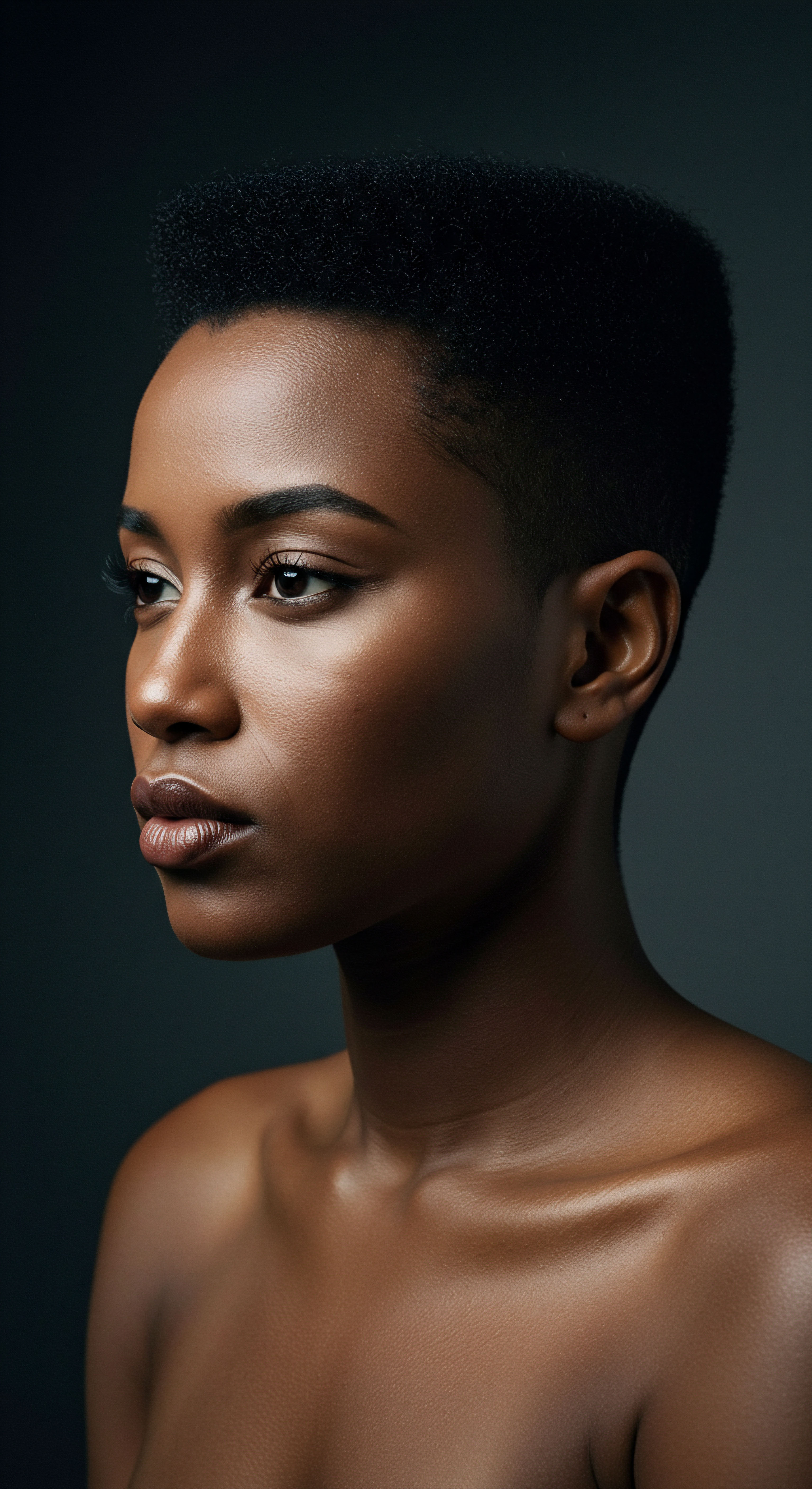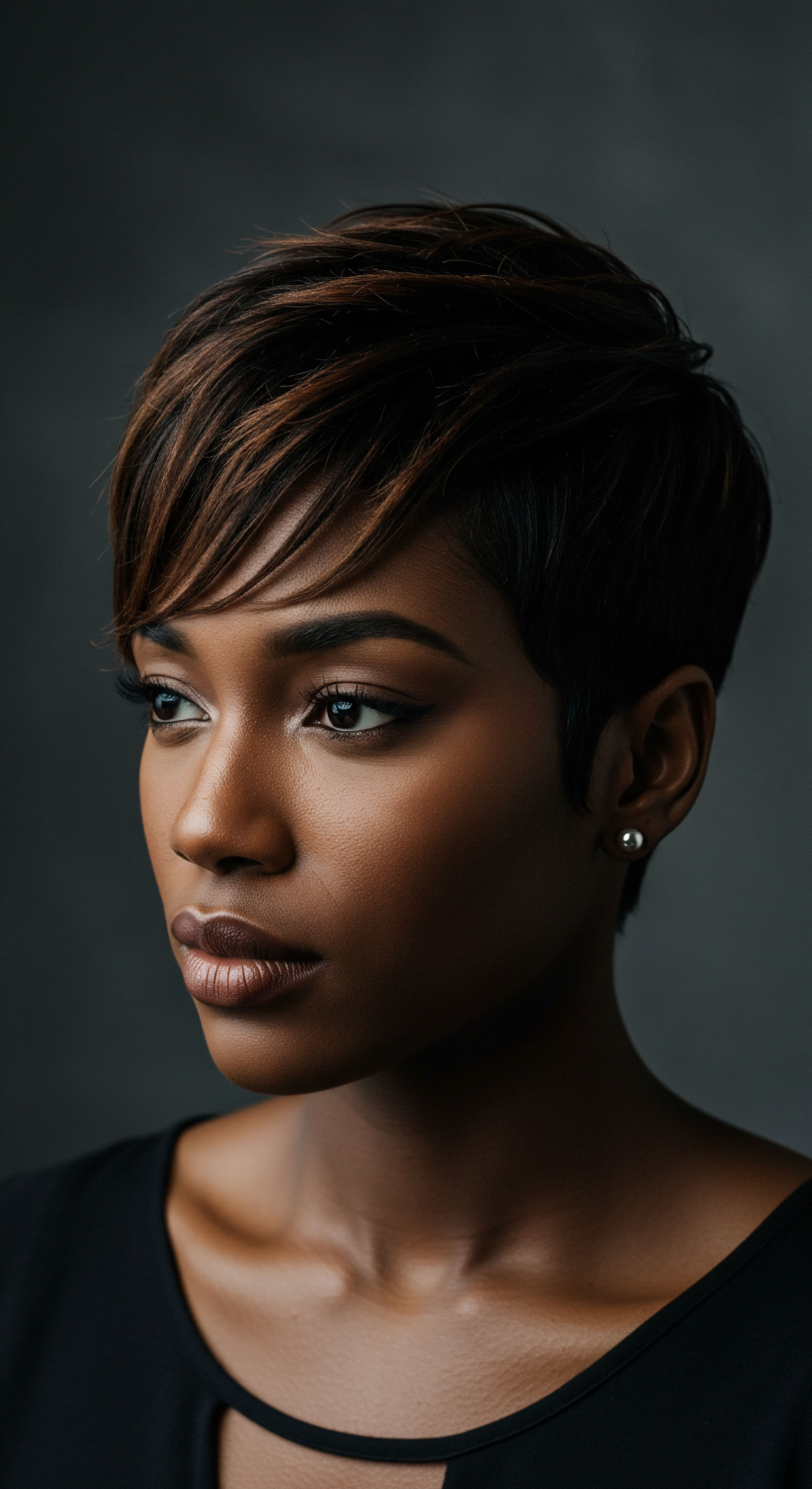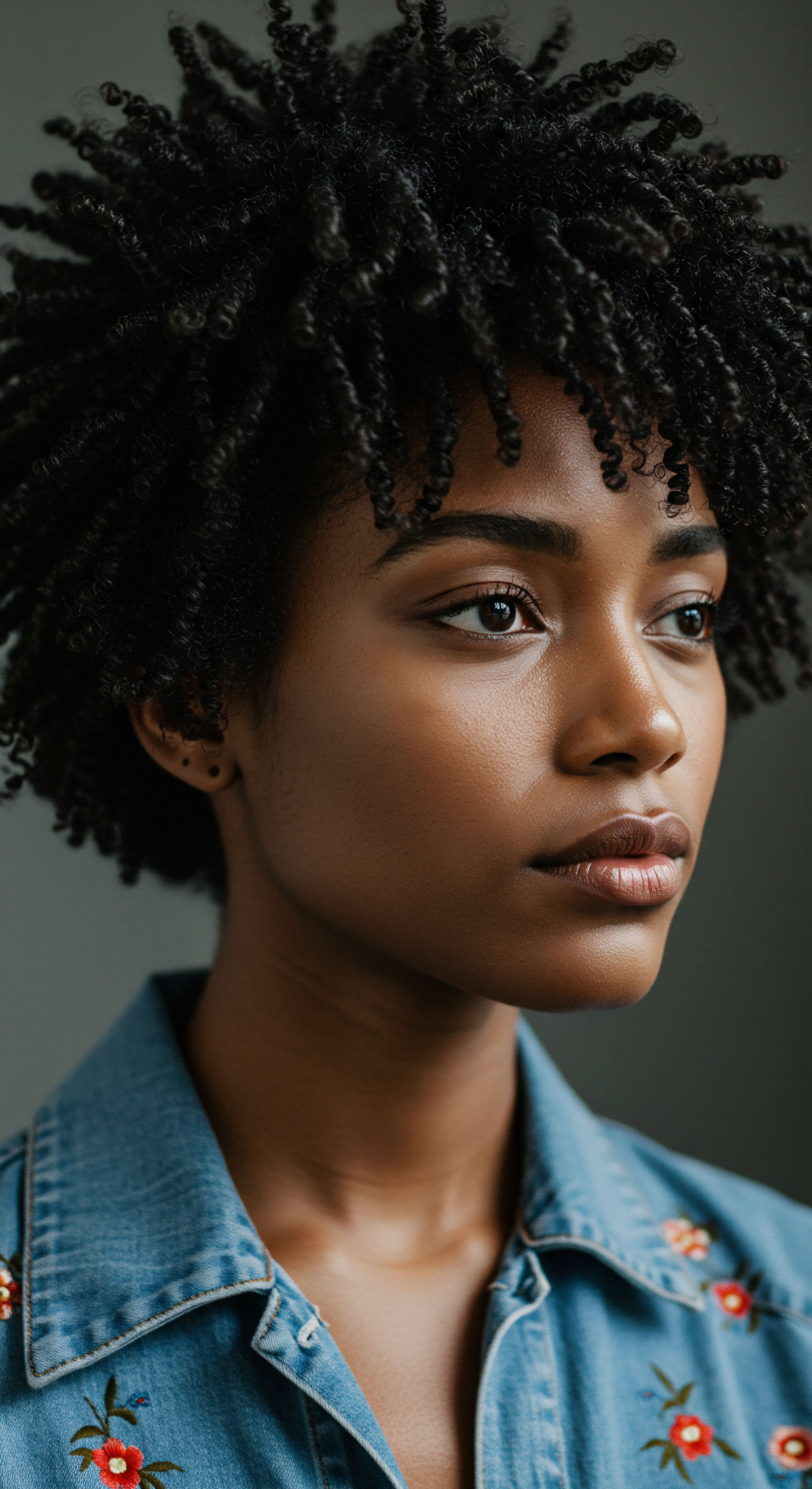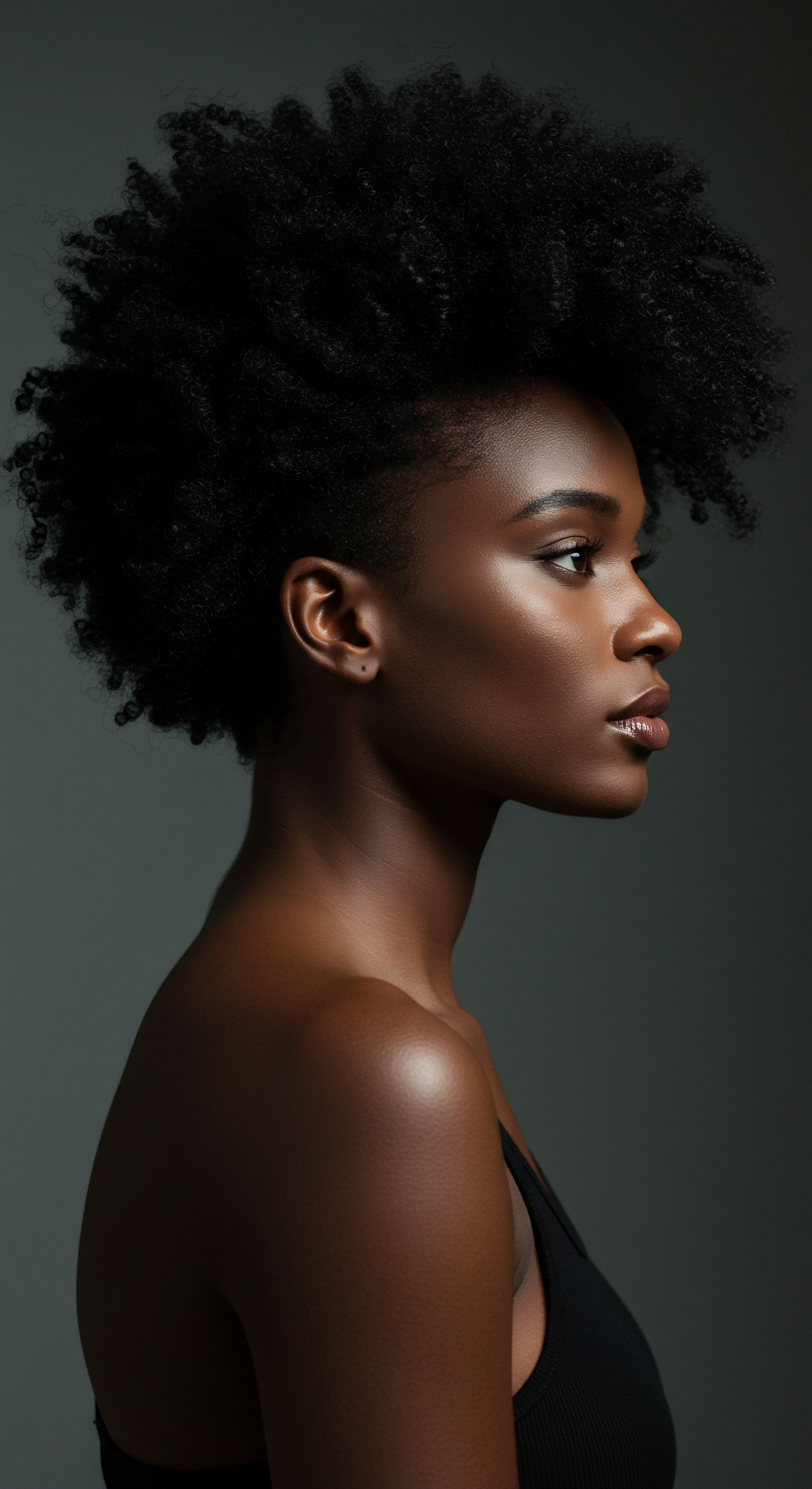
Roots
A quiet observation often whispers through our daily routines ❉ the subtle shift in our hair’s disposition with the turning of the seasons, or perhaps a sudden downpour. For those with textured hair, this whisper can swell into a chorus, a persistent dialogue between our strands and the very air around us. How deeply does this conversation between environmental humidity and our hair truly run?
Does it merely dictate a fleeting style, or does it etch a more lasting mark on the long-term vitality of our coils, curls, and waves? This exploration begins at the very foundation, within the intricate world of the hair strand itself, where the initial responses to atmospheric moisture are laid bare.

The Hair Strand’s Architecture and Humidity’s Touch
Each strand of textured hair, a marvel of biological engineering, possesses a unique architecture that influences its interaction with humidity. The outermost layer, the Cuticle, comprises overlapping scales, much like shingles on a roof. Beneath this protective shield lies the Cortex, a robust core composed of keratin proteins, giving hair its strength and elasticity. The innermost layer, the Medulla, often present in coarser hair types, can also hold moisture.
Humidity, quite simply, represents the amount of water vapor in the air. When the air carries more moisture, hair, being a hygroscopic material, readily absorbs it. This absorption occurs primarily through the cuticle. When the air is moist, the hair will expand and lengthen, making the pointer point down.
When the air is dry, the hair will contract and shorten, making the pointer point up. This uptake of water causes the hair fiber to swell. For textured hair, with its inherent twists and turns, this swelling is not uniform. The uneven expansion can lead to the cuticle scales lifting, creating a rougher surface. This lifted cuticle then allows even more moisture to enter, setting the stage for what many know as frizz.
The hair strand, a sophisticated structure of cuticle and cortex, reacts dynamically to ambient moisture levels.

Keratin Bonds and Water’s Influence
The internal structure of hair relies on various bonds, with Hydrogen Bonds playing a particularly sensitive role in relation to water. These temporary bonds form between protein peptide chains within the cortex. When hair is dry, hydrogen bonds stabilize its shape.
However, when moisture re-penetrates the hair due to humidity, these bonds are easily broken, causing the hair to revert to its original state or alter its configuration. This molecular dance is why a carefully set style can unravel in humid air.
While often associated with frizz, the interaction of water with hair’s hydrogen bonds also contributes to its elasticity. Water molecules plasticize the hair fiber, reducing the force required for a given extension. This means hair becomes more pliable in humid conditions, which can be both a blessing and a challenge for styling and managing.

Porosity’s Role in Moisture Exchange
Hair Porosity, the hair’s ability to absorb and retain moisture, significantly dictates how it responds to environmental humidity. This characteristic is largely determined by the state of the cuticle.
- High Porosity Hair ❉ This hair type has a cuticle with more widely spaced or lifted scales, often due to genetic predisposition or damage from chemical treatments or heat. It absorbs water quickly but also loses it quickly, leading to dryness and frizz in fluctuating humidity.
- Low Porosity Hair ❉ Here, the cuticle scales are tightly bound, making it difficult for moisture to enter. While this hair type resists humidity-induced frizz, it can also struggle to receive adequate hydration, feeling dry or product-resistant.
- Medium Porosity Hair ❉ This balance allows for reasonable absorption and retention of water, often considered the ideal state.
Understanding one’s hair porosity is a grounding step in navigating humidity’s effects. A study published in the Journal of Cosmetic Science observed that hair water regain increases linearly with an increase in relative humidity in the range of 40-85%. This quantifiable response underscores the direct relationship between atmospheric moisture and the hair’s water content, irrespective of its initial porosity, though the rate and extent of this absorption vary.

Does Hair Acclimatize to Humidity?
The notion of hair “acclimatizing” to humidity levels is a common point of discussion. While hair itself, being non-living, does not biologically adapt in the same way living tissues do, its behavior certainly adjusts to sustained environmental conditions. For instance, someone moving from a dry climate to a humid one might initially experience significant frizz and changes in curl pattern. Over time, as their hair care routine adapts and perhaps the hair’s overall moisture balance shifts, the visible effects might lessen.
However, the fundamental physical properties of the hair fiber and its hygroscopic nature remain. The hair will always react to the water content in the air. This adaptation is more about learned care practices and product choices than a physiological change within the hair strand itself.

Ritual
As we move from the elemental understanding of hair’s response to humidity, our attention turns to the daily rhythms and considered choices that shape our hair’s journey. How do we navigate the pervasive influence of environmental moisture in our routines? This section delves into the practical wisdom and mindful practices that help maintain the well-being of textured hair, transforming the challenge of humidity into an opportunity for thoughtful care. It is about understanding the dance between our hands, our chosen products, and the atmospheric conditions, allowing for both protection and expression.

Adapting Cleansing and Conditioning for Humid Climates
The very first steps in any hair care regimen—cleansing and conditioning—become particularly significant when considering humidity. In environments with high moisture, hair can feel weighed down or become excessively oily due to a combination of external moisture and scalp sebum. Conversely, in dry, low-humidity settings, hair can become parched and brittle.
For those in humid zones, selecting lighter, yet still hydrating, cleansers and conditioners is a mindful choice. The aim is to cleanse without stripping and to condition without overburdening the hair. Ingredients that offer a gentle balance of moisture and protection are paramount.
- Sulfate-Free Cleansers ❉ These help preserve the hair’s natural moisture barrier, preventing excessive dryness that could prompt the hair to absorb more environmental moisture.
- Lightweight Conditioners ❉ Formulations that rinse cleanly, leaving hair soft but not heavy, allow textured hair to maintain its natural bounce without succumbing to humidity-induced limpness.
- Deep Conditioning Masks ❉ Regular use, perhaps once a week, helps replenish moisture and nutrients, building resilience against environmental stressors.

The Art of Sealing and Protection
Once cleansed and conditioned, the next step often involves sealing the hair’s cuticle to minimize excessive moisture absorption or loss. This practice is especially relevant for textured hair, which can be prone to frizz when the cuticle lifts.
The use of leave-in conditioners, oils, and styling creams creates a protective barrier. For high porosity hair, which readily absorbs and releases water, sealing becomes a critical defense against the rapid swelling and de-swelling that can weaken the hair over time. While perceived hair moisturization does not always correlate with actual hair moisture content, the satisfaction expressed by consumers using product layering techniques (such as the LOC method ❉ Liquid, Oil, Cream) suggests a beneficial modification of hair’s tactile properties and overall feel.
Thoughtful product application and layering can build a shield against humidity’s unpredictable nature.

How Do Anti-Frizz Technologies Work?
The quest for frizz reduction has driven much innovation in hair care. Frizz itself is often caused by an imbalance in the hair’s moisture level. Anti-frizz products typically work by creating a barrier on the hair’s surface, smoothing down the cuticle, and thus regulating the exchange of moisture with the environment.
Many products utilize ingredients like silicones or certain cationic surfactants. These substances form a film around the hair shaft, effectively sealing the cuticle and reducing its tendency to lift in humid air. A study examining anti-frizz technologies concluded that the test conditions regarding time, temperature, and relative humidity are critical for hair’s tendency to frizz.
This highlights that even the most advanced formulations are working with the fundamental principles of how hair interacts with its surroundings. The goal is to provide a temporary, yet effective, shield that allows textured hair to maintain its definition and smoothness even when humidity levels fluctuate.

Styling Choices and Environmental Harmony
Beyond products, styling techniques themselves serve as a powerful tool in managing humidity’s influence. For textured hair, protective styles offer a significant advantage, minimizing direct exposure to the elements and reducing mechanical manipulation.
Examples of such styles include:
- Braids and Twists ❉ These styles secure the hair, preventing individual strands from swelling independently and leading to frizz. They also keep hair off the face and neck, which can be more comfortable in humid conditions.
- Buns and Updos ❉ Gathering hair into a compact shape can reduce its surface area exposed to the atmosphere, thereby lessening moisture absorption.
- Low Manipulation Styles ❉ Allowing hair to air dry or using gentle drying methods can prevent additional cuticle damage that would make hair more susceptible to humidity.
Historically, various cultures have adopted styling practices influenced by their climates. Ancient Egyptians, battling harsh desert heat, relied on natural oils to keep hair hydrated. In African cultures, intricate braids and twists were not only aesthetic but also served practical purposes, often using shea butter and plant oils to maintain hydration. These practices underscore a long-standing understanding of environmental harmony in hair care, a wisdom that continues to inform modern rituals for textured hair.

Relay
Stepping beyond the visible interactions and daily practices, we now seek a deeper understanding of humidity’s subtle, long-term whispers to textured hair. What are the more enduring echoes of environmental moisture on our strands, reaching into the very core of their resilience and structural integrity? This section invites a closer look at the scientific underpinnings and broader contextual factors that shape textured hair’s response to its environment, revealing complexities that extend beyond a simple “good hair day” or “bad hair day.”

The Molecular Echoes of Constant Moisture Exchange
Textured hair, with its unique helical structure, experiences constant dimensional changes as it absorbs and desorbs water with fluctuations in environmental humidity. This phenomenon, known as Hygral Fatigue, involves repeated swelling and de-swelling of the hair fiber. While seemingly benign, this continuous movement can place stress on the cuticle layers, potentially leading to micro-fissures and gradual degradation over time. The cuticle, the hair’s primary defense, becomes compromised, exposing the inner cortex to further environmental stressors.
Research on hair elasticity indicates that moisture variations in the cuticle sheath significantly influence its shear and tensile modulus, impacting overall hair mechanical and cosmetic properties. An imbalance in moisture content within the cuticle cell inter and intra-layers can generate stress concentrations across interfaces, leading to damage at the cuticle cell boundaries. This suggests that chronic, unregulated moisture exchange can contribute to long-term structural weakening.

Protein Loss and Oxidative Stress
Beyond direct mechanical stress, humidity can also play a role in broader environmental damage, indirectly impacting hair health. High humidity often coincides with higher temperatures and increased levels of air pollutants. Airborne pollutants, including particulate matter, can accumulate on the hair and scalp, generating free radicals and oxidative stress. This oxidative stress can damage hair proteins and melanin, leading to weakening of the hair shaft, color changes, and even hair loss over time.
A study by Son and Kwon (2025) highlights that continuous exposure to particulate matter from air pollution can cause oxidative stress, leading to scalp problems and hair damage. While humidity itself is not a direct pollutant, its presence can exacerbate the adherence and penetration of these harmful particles, especially if the cuticle is already lifted. This interconnectedness means that managing humidity is not solely about frizz, but also about protecting hair from a cascade of environmental aggressors.
| Environmental Factor High Humidity |
| Immediate Hair Response Swelling, frizz, curl definition changes, increased pliability. |
| Potential Long-Term Influence on Textured Hair Hygral fatigue, cuticle damage, increased susceptibility to breakage, potential for fungal growth on scalp if sustained. |
| Environmental Factor Low Humidity (Dry Air) |
| Immediate Hair Response Dryness, brittleness, static electricity, reduced elasticity. |
| Potential Long-Term Influence on Textured Hair Increased breakage, scalp dryness, dullness, loss of natural oils. |
| Environmental Factor UV Radiation |
| Immediate Hair Response Protein degradation, color fading, cuticle damage. |
| Potential Long-Term Influence on Textured Hair Weakened hair structure, loss of tensile strength, increased porosity, chronic dryness. |
| Environmental Factor Air Pollution |
| Immediate Hair Response Surface accumulation, oxidative stress, scalp irritation. |
| Potential Long-Term Influence on Textured Hair Hair thinning, loss of luster, increased breakage, folliculitis, premature graying. |
| Environmental Factor Understanding these influences aids in developing comprehensive hair care strategies. |

Does High Humidity Accelerate Hair Breakage in Textured Hair?
This question reaches into the very resilience of textured strands. While high humidity makes hair more pliable and less prone to snapping from acute mechanical stress when wet, prolonged exposure to fluctuating humidity levels can contribute to a different kind of fragility. The constant swelling and contracting of the hair fiber, particularly at the points where it naturally curves or coils, can lead to cumulative stress. This stress can weaken the hair’s structural integrity over time, making it more susceptible to breakage during routine manipulation, even if the individual event itself seems gentle.
A study with light and scanning electron microscopy revealed that natural African hair removed by combing exhibits a significantly higher incidence of knotting and breaking of the hair shafts compared with Caucasian and Asian hair. While this study does not directly isolate humidity as the sole cause, it underscores the inherent fragility of textured hair, which is then compounded by environmental factors like humidity that promote swelling and cuticle disruption. The moisture content in African descent hair is slightly lower than in Caucasian hair, and sebum distribution is uneven, contributing to a drier appearance. This dryness, combined with humidity-induced swelling, creates a cycle of vulnerability.
The repeated expansion and contraction from humidity, while not immediately damaging, can contribute to the long-term weakening of textured hair.

Cultural Contexts and Climate Adaptation
The influence of environmental humidity on textured hair is not solely a scientific matter; it is deeply intertwined with cultural practices and historical adaptations. Across diverse populations, hair care traditions have evolved in response to local climates. For instance, populations in tropical zones, characterized by saturating humidity, often exhibit water-repellant, dense, coarse hair. This hair type may naturally prevent dryness at the surface, retaining moisture from secreted oils.
In many African cultures, hair has served as a symbol of identity, status, and communication. Practices involving natural butters, herbs, and powders were employed to assist with moisture retention, a clear response to the challenges of often-humid environments. The history of hair care in African American women, for example, shows how practices such as thermal ironing were used to counteract the effects of humidity and wetness, a practice that, while offering temporary straightness, could also lead to breakage and a coarse, dry texture over time. This historical context highlights how societal pressures and environmental conditions have shaped not only hair care routines but also perceptions of hair health and beauty.
Understanding these cultural responses provides a richer perspective on the ongoing dialogue between textured hair and environmental humidity, moving beyond a purely scientific lens to embrace the lived experiences that define our hair journeys.

Reflection
The conversation between textured hair and environmental humidity is a dynamic and intricate one, far from a simple equation of cause and effect. It is a dialogue that unfolds at the molecular level, in our daily rituals, and across the expanse of cultural history. We have seen how the very structure of textured hair, with its unique cuticle and cortex, reacts to the ebb and flow of atmospheric moisture, leading to changes in pliability and, at times, frizz. The long-term implications, while not always immediately apparent, point to a cumulative stress on the hair fiber from repeated swelling and contraction, compounded by the presence of environmental pollutants.
Yet, within this complex interaction lies an invitation for deeper understanding and a more attuned approach to care. Recognizing the inherent resilience of textured hair, and honoring the diverse ways in which communities have historically responded to their environments, empowers us to move beyond fleeting concerns. The goal becomes one of sustained well-being, fostering a relationship with our hair that is informed by science, enriched by tradition, and guided by a gentle, persistent care.

References
- Robbins, C. R. (2012). Chemical and Physical Behavior of Human Hair. Springer Science & Business Media.
- Gammon, R. (2007). Evaluation of hair humidity resistance/moisturization from hair elasticity. Journal of Cosmetic Science, 58(4), 393-404.
- Son, E. & Kwon, K. H. (2025). The Invisible Threat to Hair and Scalp from Air Pollution. Polish Journal of Environmental Studies, 34(2), 1745-1753.
- Byrd, A. D. & Tharps, L. L. (2014). Hair Story ❉ Untangling the Roots of Black Hair in America. St. Martin’s Press.
- Velasco, M. V. R. Dias, T. C. S. de Freitas, A. Z. Vieira Júnior, N. D. Pinto, C. A. S. O. Kaneko, T. M. & Baby, A. R. (2014). Hair fiber characteristics and methods to evaluate hair physical and mechanical properties. Brazilian Journal of Pharmaceutical Sciences, 50(1), 1-13.
- Khazaka, J. P. (2019). The Secrets of Beautiful Hair ❉ Why is it Flexible and Elastic?. MDPI Materials, 12(13), 2097.
- Gavazzoni Dias, M. F. R. (2015). Hair cosmetics ❉ an overview. International Journal of Trichology, 7(1), 2-15.
- Feughelman, M. (1997). Mechanical Properties of Hair. In Hair and Hair Diseases (pp. 131-140). Springer.
- Wortmann, F. J. & Wortmann, G. (2009). Hair fiber science ❉ an overview. Journal of Cosmetic Science, 60(2), 177-189.
- Porter, D. (2001). The Chemistry and Manufacture of Cosmetics. Allured Publishing Corporation.